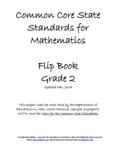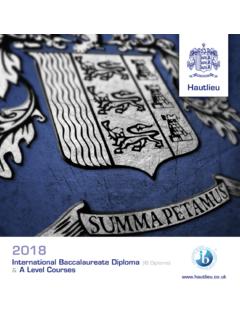Transcription of Common Core Standards for Mathematics Flip Book Grade 6
1 Common core Standards for Mathematics flip Book Grade 6. Updated Fall, 2014. This project used the work done by the Departments of Educations in Ohio, North Carolina, Georgia, engageNY, NCTM, and the Tools for the Common core Standards . Compiled by Melisa J. Hancock, for questions or comments about the flipbooks please contact Melisa Formatted by Melissa Fast Planning Advice--Focus on the Clusters The Mathematics Standards ) call for a greater focus. Rather than racing to cover topics in today's mile-wide, inch-deep curriculum, we need to use the power of the eraser and significantly narrow and deepen how time and energy is spent in the Mathematics classroom. There is a necessity to focus deeply on the major work of each Grade to enable students to gain strong foundations: solid conceptually understanding, a high degree of procedural skill and fluency, and the ability to apply the Mathematics they know to solve problems both in and out of the Mathematics classroom.
2 ( ). As the Kansas College and Career Ready Standards (KCCRS) are carefully examined, there is a realization that with time constraints of the classroom, not all of the Standards can be done equally well and at the level to adequately address the Standards . As a result, priorities need to be set for planning, instruction and assessment. Not everything in the Standards should have equal priority (Zimba, 2011). Therefore, there is a need to elevate the content of some Standards over that of others throughout the K-12 curriculum. When the Standards were developed the following were considerations in the identification of priorities: 1) the need to be qualitative and well-articulated; 2) the understanding that some content will become more important than other; 3). the creation of a focus means that some essential content will get a greater share of the time and resources While the remaining content is limited in scope.
3 4) a lower priority does not imply exclusion of content but is usually intended to be taught in conjunction with or in support of one of the major clusters. The Standards are built on the progressions, so priorities have to be chosen with an eye to the arc of big ideas in the Standards . A prioritization scheme that respects progressions in the Standards will strike a balance between the journey and the endpoint. If the endpoint is everything, few will have enough wisdom to walk the path, if the endpoint is nothing, few will understand where the journey is headed. Beginnings and the endings both need particular care. It would also be a mistake to identify such standard as a locus of emphasis. (Zimba, 2011). The important question in planning instruction is: What is the Mathematics you want the student to walk away with? . In planning for instruction grain size is important.
4 Grain size corresponds to the knowledge you want the student to know. Mathematics is simplest at the right grain size. According to Daro (Teaching Chapters, Not Lessons Grain Size of Mathematics ), strands are too vague and too large a grain size, while lessons are too small a grain size. About 8 to 12. units or chapters produce about the right grain size . In the planning process staff should attend to the clusters, and think of the Standards as the ingredients of cluster, while understanding that coherence exists at the cluster level across grades. A caution--Grain size is important but can result in conversations that do not advance the intent of this structure. Extended discussions that argue 2 days instead of 3 days on a topic because it is a lower priority detract from the overall intent of suggested priorities. The reverse is also true. As Daro indicates, lenses focused on lessons can also provide too narrow a view which compromises the coherence value of closely related Standards .
5 The video clip Teaching Chapters, Not Lessons Grain Size of Mathematics that follows presents Phil Daro further explaining grain size and the importance of it in the planning process. (Click on photo to view video.). Along with grain size , clusters have been given priorities which have important implications for instruction. These priorities should help guide the focus for teachers as they determine allocation of time for both planning and instruction. The priorities provided help guide the focus for teachers as they demine distribution of time for both planning and instruction, helping to assure that students really understand before moving on. Each cluster has been given a priority level. As professional staffs begin planning, developing and writing units as Daro suggests, these priorities provide guidance in assigning time for instruction and formative assessment within the classroom.
6 Each cluster within the Standards has been given a priority level by Zimba. The three levels are referred to as: Focus, Additional and Sample. Furthermore, Zimba suggests that about 70% of instruction should relate to the Focus clusters. In planning, the lower two priorities (Additional and Sample) can work together by supporting the Focus priorities. The advanced work in the high school Standards is often found in Additional and Sample clusters . Students who intend to pursue STEM careers or Advance Placement courses should master the material marked with + within the Standards . These Standards fall outside of priority recommendations. Recommendations for using cluster level priorities Appropriate Use: Use the priorities as guidance to inform instructional decisions regarding time and resources spent on clusters by varying the degrees of emphasis Focus should be on the major work of the Grade in order to open up the time and space to bring the Standards for Mathematical Practice to life in Mathematics instruction through: sense-making, reasoning, arguing and critiquing, modeling, etc.
7 Evaluate instructional materials by taking the cluster level priorities into account. The major work of the Grade must be presented with the highest possibility quality; the additional work of the Grade should indeed support the Focus priorities and not detract from it. Set priorities for other implementation efforts taking the emphasis into account such as: staff development; new curriculum development; revision of existing formative or summative testing at the state, district or school level. Things to Avoid: Neglecting any of the material in the Standards rather than connecting the Additional and Sample clusters to the other work of the Grade Sorting clusters from Focus to Additional to Sample and then teaching the clusters in order. To do so would remove the coherence of mathematical ideas and miss opportunities to enhance the focus work of the Grade with additional clusters.
8 Using the clusters' headings as a replacement for the actual Standards . All features of the Standards matter . from the practices to surrounding text including the particular wording of the individual content Standards . Guidance for priorities is given at the cluster level as a way of thinking about the content with the necessary specificity yet without going so far into detail as to comprise and coherence of the Standards (grain size). Depth Opportunities Each cluster, at a Grade level, and, each domain at the high school, identifies five or fewer Standards for in-depth instruction called Depth Opportunities (Zimba, 2011). Depth Opportunities (DO) is a qualitative recommendation about allocating time and effort within the highest priority clusters --the Focus level. Examining the Depth Opportunities by standard reflects that some are beginnings, some are critical moments or some are endings in the progressions.
9 The DO's provide a prioritization for handling the uneven grain size of the content Standards . Most of the DO's are not small content elements, but, rather focus on a big important idea that students need to develop. DO's can be likened to the Priorities in that they are meant to have relevance for instruction, assessment and professional development. In planning instruction related to DO's, teachers need to intensify the mode of engagement by emphasizing: tight focus, rigorous reasoning and discussion and extended class time devoted to practice and reflection and have high expectation for mastery. (See Depth of Knowledge (DOK), Table 7, Appendix). In this document, Depth Opportunities are highlighted pink in the Standards section. For example: Find whole number quotients of whole numbers with up to four-digit dividends and two-digit divisors, using strategies based on place value, the properties of operations, and/or the relationship between multiplication and division.
10 Illustrate and explain the calculation by using equations, rectangular arrays and/or area models. Depth Opportunities can provide guidance for examining materials for purchase, assist in professional dialogue of how best to develop the DO's in instruction and create opportunities for teachers to develop high quality methods of formative assessment. Standards for Mathematical Practice in Grade 6. The Common core State Standards for Mathematical Practice are practices expected to be integrated into every Mathematics lesson for all students Grades K-12. Below are a few examples of how these Practices may be integrated into tasks that Grade 2 students complete. Practice Explanation and Example 1) Make Sense Mathematically proficient students in Grade 6 start by explaining to themselves the meaning of the problem and looking for entry points and Persevere in to its solution.







